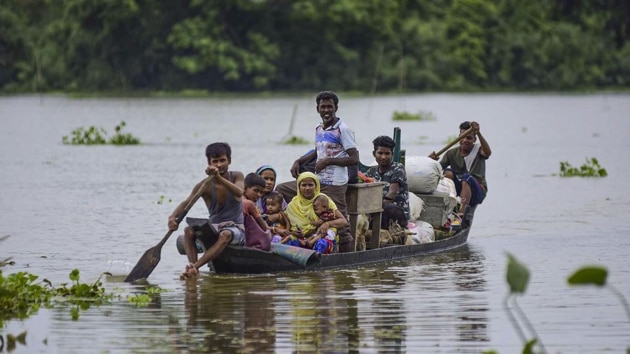Average monsoon rain is going down, but extreme flooding is increasing
Floods, which are an annual phenomenon in Assam, have marooned 30 of the 33 districts of the state affecting around 4.28 million people, according to the state disaster management authority officials.
The north-east, especially Assam, has witnessed a “significant decreasing” trend in the average monsoon rainfall since 1870 even as extreme rainfall or sudden downpour days that lead to frequent flooding are on the rise, studies based on India Meteorological Department (IMD) data show.

Floods, which are an annual phenomenon in Assam, have marooned 30 of the 33 districts of the state affecting around 4.28 million people, according to the state disaster management authority officials. (By Wednesday, the number of districts affected had reduced by one). They, however, claimed deaths were lesser this year because of “government preparedness”. As compared to 30 deaths this year, 45 people died in floods in 2018, 85 in 2017 and 38 people in 2016, according to Assam government data.
The long-term rainfall data for Assam, however, shows a decreasing trend that has accelerated since 1981. The annual average rainfall for Assam is 1,524.6 mm. The average rainfall deficiency between 1871 and 2016 was 0.74 mm per decade, but in the period between 1981-2016, the average rainfall deficiency has been 5.95 mm per decade.
A study conducted by Punebased Indian Institute of Tropical Meteorology (IITM) last year made this observation based on IMD data. In the same period, east Uttar Pradesh, and Meghalaya and sub-Himalayan West Bengal have also shown a decreasing trend in average rainfall, while an increasing trend can be seen in East Rajasthan, Saurashtra, Kutch and Diu, the study found.
The study, based on the monsoon rainfall data between 1871 and 2016 for 306 rain gauge stations across India also showed that the mean monsoon rainfall has also decreased “significantly” — about 10 percentage points — for other north-eastern states of Nagaland, Meghalaya, Manipur, Mizoram and Tripura during the same period.
Thus, the amount of rainfall in this region is falling, and the deficiency is widening. M Rajeevan, who co-authored the study with D R Kothwale, confirmed that the average rainfall pattern in Assam was indeed falling, especially during the monsoon months.
However, a look at the daily rainfall data clearly indicates that days where there have been sudden downpours [or extreme rainfall events] have in fact increased, thus leading to extreme flooding in several parts of the Brahmaputra valley in the state, Rajeevan pointed out.
As one-fourth of the total rainfall during four monsoon months (June to September) happens in July, according to the IITM study, the probability of flooding during July is the highest. Various studies in the past have shown that average monsoon rainfall in India was falling whereas extreme rainfall events have increased by about 5%.
Indeed, this might be one of the reasons why we do not perceive the problem: we assume that since there is flooding, it must mean that the season’s rainfall has been excessive.
NOT A SMALL DEAL
The average monsoon rainfall deficiency of 5.95 mm per decade may seem insignificant, but when seen in tandem with district-wise rain data, the rainfall pattern within the state reveals a variance. For example, Dhubri district received 69.8 mm per decade less rainfall between 1986 and 2015, according to a study titled Variability and Trends of Rainfall Events in the Brahmaputra Valley of Assam published in International Journal of Current Microbiology and Applied sciences in 2017.
The 2017 study said the Brahmaputra and Barak are two main rivers of Assam and their basins cover 56,194 sq km and 22,244 sq km respectively of the state’s total geographical area of about 78,438 sq km. “Due to ecological and climate difference from one place to another, these valleys always experience, from time to time, both excessive as well as insufficient rainfall, as [a] result [of which] agricultural production [is] often seriously affected,” the study said. The study on rainfall in the Brahmaputra valley showed a weakening relationship between El Nino Southern Oscillation (ENSO), and the Indian monsoon might be the possible reasons of decreasing frequency of rainfall events in Assam.
“These decreases in monsoon depressions over the Bay of Bengal might have played a major role in the decrease in the amount of monsoon rainfall in the Brahmaputra valley during the period of study,” the study said.
However, the cause of floods in Assam may not necessarily be rainfall within the state alone. Experts say the rainfall in China and Bhutan also contributes to flooding in the state. “Both Brahmaputra and Barack rivers and their tributaries originate in other countries and [their] waters flow downstream... This year also, there has been heavy rainfall in China and Bhutan which has caused the flooding,” an official of Assam’s disaster management authority said.
.
Get Current Updates on India News, Ram Navami Live Updates , Lok Sabha Election 2024 live, Elections 2024, Election 2024 Date along with Latest News and Top Headlines from India and around the world.




